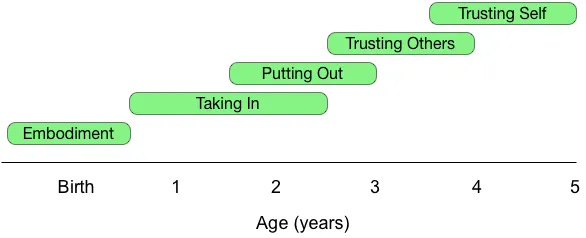Child Development and Adult Character
Introducing BFNow Self-Study Module 3
This is the third in a weekly series of posts introducing you to the modules in the BFNow Self-Study program.
In Module 3 we focus on the influence of child development on adult character using an approach called Character Styles.
Character Styles are defense patterns rooted in common childhood challenges. There are five of them. In the module, we call them Leaving, Pulling, Enduring, Controlling and Performing based on their main behavior under stress. I have yet to meet anyone who doesn’t manifest some degree of at least one of these and most people recognize more than one in themselves.
Each is connected to an emotionally significant developmental task:
Whenever there is some kind of developmental trauma that causes one of these tasks to get distorted or to not complete in an age-appropriate way, the child
misses out on developing important skills
acquires various limiting beliefs
develops various emotional landmines that can be triggered into re-evoking the pain of the initial trauma
The child then compensates by developing various defense patterns and workaround behaviors, which often continue into adult life. The defensive patterns can either be acute, arising in direct response to some trigger, or they can be preemptive/anticipatory, there in an attempt to prevent triggering.
In effect, each Character Style is a survival strategy. As a system, we can map it like this:
I’ve worked with this approach for thirty years and found it immensely helpful for understanding and healing my own wounds.
Some of the things I’ve found that make it work so well are:
It connects the behavior to the wound in an empirically grounded meaningful way. This makes it possible to respond, for myself and to others, in a healing way rather than simply reacting to the surface behavior. It provides a language for understanding and strategies for healing the defensive patterns that move you out of your Optimal Zone when you feel stressed or threatened.
Since the BFNow program encourages us to see ourselves as complex territories with multiple sub-personalities (see Module 1, Exploration 2), we can connect the Character Styles to sub-personalities rather than making them globally about who you are. This proves to be more flexible, accurate and empowering than categorical personality profile systems like Myers-Briggs and the Enneagram. I experience each of the Character Styles in myself to varying degrees in various sub-personalities. I’m glad I do, since my self-knowledge makes it easier for me to compassionately understand others as well as myself.
This is a deep module with a lot of content but well worth it. From the perspective of the Foundational Keys, it contributes to Being Savvy about Psychodynamics. I encourage you to take a look, starting with the Overview, which is particularly important for this module.
Here are the pages:
Child Development and Adult Character – Module 3 Overview
Embodiment/Leaving – Exploration 1
Taking In/Pulling – Exploration 2
Putting Out/Enduring – Exploration 3
Trusting Others/Controlling – Exploration 4
Trusting Self/Performing – Exploration 5
For quick access to the other modules, please see About BFNow Self-Study. For a more detailed orientation to both the content and process of the Self-Study program, see BFNow Self-Study Orientation.



